NAGAOKAMEICHIKU-Takegaki

NAGAOKAMEICHIKU-Takegaki
The Japanese term takegaki refers to bamboo fences that surround or partition houses or gardens.
They were originally conceived and came into being as a means of protecting life and property.
It is said that the creation of takegaki dates as far back as the Nara period (710-794), when the areas around aristocratic estates were enclosed by hedges and bamboo fences.
The development of tea culture (that is, the tea ceremony or sadō) through the successful efforts of Sen no Rikyū during the Azuchi-Momoyama period (1573-1596) led to the birth of sukiya architecture that is characteristic of tea-ceremony arbors, and the subsequent spread of the style of gardening associated with sukiya architecture has led to the further development and popularity oftakegaki today.
Takegaki is a fence (kakine) constructed with bamboo (take), and as many as twenty different styles of takegaki are still in regular use in contemporary Japanese gardening.
Based in Kyoto, Nagaokameichiku is an artisan studio specializing in bamboo products, and particularly in the construction of bamboo fences, long recognized as integral components of the traditional Japanese townscape. Our creations are fashioned individually and by hand, espousing the cultural “wabi-sabi” aesthetic ever out of reach for factory-produced goods.
"Wabi-sabi" refers to inner beauty that reveals itself as time goes by.
This aesthetic sense applies to bamboo fences as well, which develop beauty and different appearances with the passage of time.
Nagaokameichiku makes bamboo fences that are refreshingly beautiful, with appearances that soothe the spirit and only gain further depth as time passes.
Our recent activities extend internationally, with demonstrations, lectures, exhibits, workshops, and networking events pertaining to bamboo craftsmanship held in countries such as the US and Italy. We also welcome craftsmen from abroad, for opportunities to study the art of bamboo fence making with us in Kyoto.
Nagaokameichiku craftsmanship is found among the grounds of Japan’s most noted cultural treasures, including Katsura Imperial Villa (Katsura Rikyū), the Golden Pavilion (Kinkaku-ji Temple), and Kyoto Imperial Palace (Kyōto Gosho). In recent years, our work has been featured across both domestic and international media. Bamboo enjoys renewed attention as a material that can help realize a sustainable, environmentally-friendly society. Using such materials, we are proud to offer our services to clientele not only within Japan but across the globe, fashioning one-of-a-kind bamboo creations that bring joy to the lives they touch.
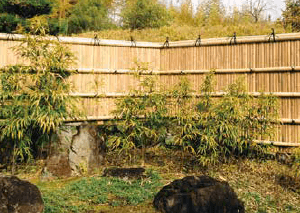 Ken'nin-ji-gaki:
Ken'nin-ji-gaki: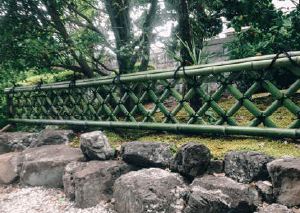 Ryōan-ji-gaki:
Ryōan-ji-gaki: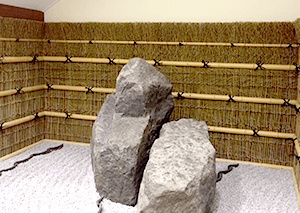 Take’eda hogaki:
Take’eda hogaki:Location:Anderson Japanese Gardens
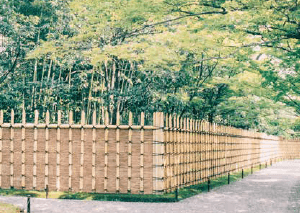 Take’eda rikyū-gaki:
Take’eda rikyū-gaki: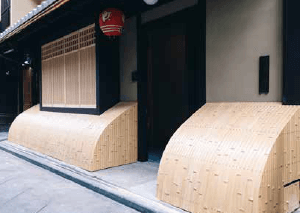 Komayose:
Komayose: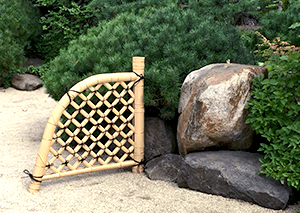 Kōetsu-ji-gaki:
Kōetsu-ji-gaki:Location:Anderson Japanese Gardens
“Responsible Consumption and Production” - this is one of the Sustainable Development Goals (SDGs). We have recently heard about environmental problems related to bamboo, material of our products. One of them is abandoned bamboo forest, partly caused by reduced demand of bamboo products.
Bamboo products have been familiar to our daily life since ancient times, but their place has been taken over by plastic products. Reduced demand means reduced number of people taking care of the material. Thus bamboo, which is supposed to be appropriately cut and controlled, started to be abandoned.
Today there are many environmental problems in the world. People started to notice the need to take actions to attain sustainable society. Our actions as a producer is the followings:
We use material close to our factory and reduce carbon footprint of transportation.
We maintain environment of bamboo forests to have sound circulation of material
We use as many parts of material as possible to reduce trash
We have developed a bamboo pile to install a net for deer prevention so that young trees can grow in revitalized forest.Bamboo piles eventually return to the soil.
We also hold workshops so that people can work with bamboo and learn the situation and problems the material we consume are facing. We hope that people will have mind to consume more responsibly for the environment.
We keep trying to be more environmentally friendly through looking back conventional ways and taking specific actions.